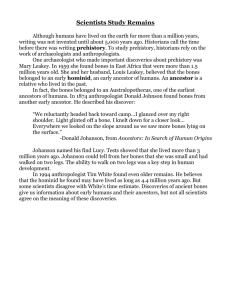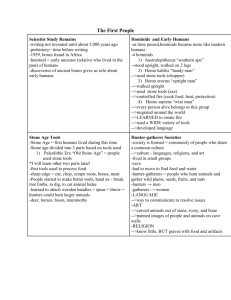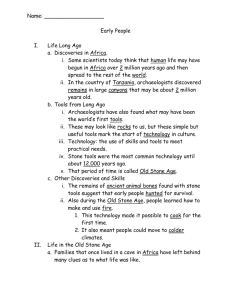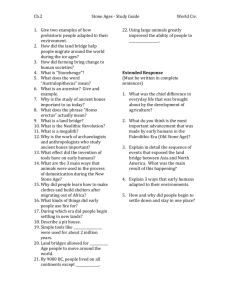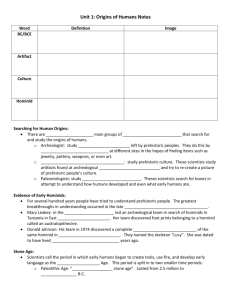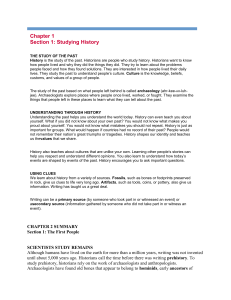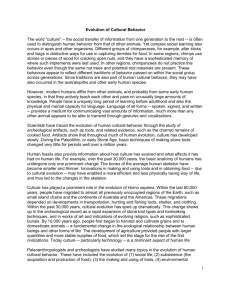Scientists Study Remains
advertisement
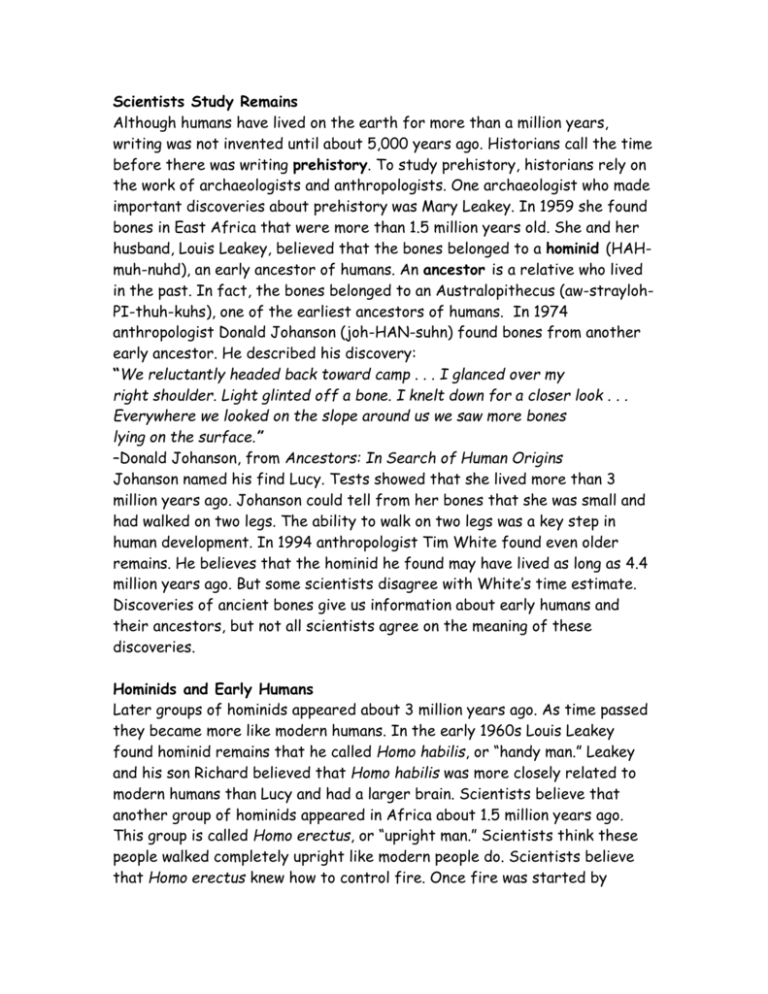
Scientists Study Remains Although humans have lived on the earth for more than a million years, writing was not invented until about 5,000 years ago. Historians call the time before there was writing prehistory. To study prehistory, historians rely on the work of archaeologists and anthropologists. One archaeologist who made important discoveries about prehistory was Mary Leakey. In 1959 she found bones in East Africa that were more than 1.5 million years old. She and her husband, Louis Leakey, believed that the bones belonged to a hominid (HAHmuh-nuhd), an early ancestor of humans. An ancestor is a relative who lived in the past. In fact, the bones belonged to an Australopithecus (aw-straylohPI-thuh-kuhs), one of the earliest ancestors of humans. In 1974 anthropologist Donald Johanson (joh-HAN-suhn) found bones from another early ancestor. He described his discovery: “We reluctantly headed back toward camp . . . I glanced over my right shoulder. Light glinted off a bone. I knelt down for a closer look . . . Everywhere we looked on the slope around us we saw more bones lying on the surface.” –Donald Johanson, from Ancestors: In Search of Human Origins Johanson named his find Lucy. Tests showed that she lived more than 3 million years ago. Johanson could tell from her bones that she was small and had walked on two legs. The ability to walk on two legs was a key step in human development. In 1994 anthropologist Tim White found even older remains. He believes that the hominid he found may have lived as long as 4.4 million years ago. But some scientists disagree with White’s time estimate. Discoveries of ancient bones give us information about early humans and their ancestors, but not all scientists agree on the meaning of these discoveries. Hominids and Early Humans Later groups of hominids appeared about 3 million years ago. As time passed they became more like modern humans. In the early 1960s Louis Leakey found hominid remains that he called Homo habilis, or “handy man.” Leakey and his son Richard believed that Homo habilis was more closely related to modern humans than Lucy and had a larger brain. Scientists believe that another group of hominids appeared in Africa about 1.5 million years ago. This group is called Homo erectus, or “upright man.” Scientists think these people walked completely upright like modern people do. Scientists believe that Homo erectus knew how to control fire. Once fire was started by natural causes, such as lightning, people used it to cook food. Fire also gave them heat and protection against animals. Eventually hominids developed characteristics of modern humans. Scientists are not sure exactly when or where the first modern humans lived. Many think that they first appeared in Africa about 200,000 years ago. Scientists call these people Homo sapiens, or “wise man.” Every person alive today belongs to this group. Stone Age Tools The first humans and their ancestors lived during a long period of time called the Stone Age. To help in their studies, archaeologists divide the Stone Age into three periods based on the kinds of tools used at the time. To archaeologists, a tool is any handheld object that has been modified to help a person accomplish a task. The first part of the Stone Age is called the Paleolithic (pay-lee-uh-LI-thik) Era , or Old Stone Age. It lasted until about 10,000 years ago. During this time people used stone tools. The First Tools Scientists have found the oldest tools in Tanzania, a country in East Africa. These sharpened stones, about the size of an adult’s first, are about 2.6 million years old. Each stone had been struck with another rock to create a sharp, jagged edge along one side. This process left one unsharpened side that could be used as a handle. Scientists think that these first tools were mostly used to process food. The sharp edge could be used to cut, chop, or scrape roots, bones, or meat. Tools like these, called choppers, were used for about 2 million years. Later Tools Over time people learned to make better tools. For example, they developed the hand ax. They often made this tool out of a mineral called flint. Flint is easy to shape, and tools made from it can be very sharp. People used hand axes to break tree limbs, to dig, and to cut animal hides. People also learned to attach wooden handles to tools. By attaching a wooden shaft to a stone point, for example, they invented the spear. Because a spear could be thrown, hunters no longer had to stand close to animals they were hunting. As a result, people could hunt larger animals. Among the animals hunted by Stone Age people were deer, horses, bison, and elephant like creatures called mammoths. Hunter-gatherer Societies As early humans developed tools and new hunting techniques, they formed societies. A society is a community of people who share a common culture. These societies developed cultures with languages, religions, and art. Society Anthropologists believe that early humans lived in small groups. In bad weather they might have taken shelter in a cave if there was one nearby. When food or water became hard to fi nd, groups of people would have to move to new areas. The early humans of the Stone Age were hunter-gatherers —people who hunt animals and gather wild plants, seeds, fruits, and nuts to survive. Anthropologists believe that most Stone Age hunters were men. They hunted in groups, sometimes chasing entire herds of animals over cliffs. This method was both more productive and safer than hunting alone. Women in hunter-gatherer societies probably took responsibility for collecting plants to eat. They likely stayed near camps and took care of children. Language, Art, and Religion The most important development of early Stone Age culture was language. Scientists have many theories about why language first developed. Some think it was to make hunting in groups easier. Others think it developed as a way for people to form relationships. Still others think language made it easier for people to resolve issues like how to distribute food. Language wasn’t the only way early people expressed themselves. They also created art. People carved figures out of stone, ivory, and bone. They painted and carved images of people and animals on cave walls. Scientists still aren’t sure why people made art. Perhaps the cave paintings were used to teach people how to hunt, or maybe they had religious meanings. Scholars know little about the religious beliefs of early people. Archaeologists have found graves that included food and artifacts. Many scientists think these discoveries are proof that the first human religions developed during the Stone Age.
